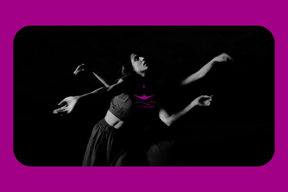Dance for Yourself, Not for What you See in the Mirror
In popular culture, dance is often seen as a technique used to make one look aesthetic, beautiful, attractive, or to perform movements with extreme flexibility.
We are drawn to watching moments that appeal to our gaze and evoke certain emotions within us because as humans, we seek the vitality of the living. Unlike sports, dance is a method where feelings, emotions, and our psychological state accompany the movements, which is why it creates transformation not only in the body but in every layer of our being.
Our sense of rhythm is as old as human history itself. Life is rhythm, and the ability of the body to synchronize with this rhythm is a talent inherent in every human. While some of us have more active motor skills, and others have a clearer sense of rhythm, dance is, in fact, a natural element of everything in nature. Just like the mating dances of animals or a flower turning its face toward the sun, when we move beyond automatically perceiving actions and instead notice their transitions and internal harmony, we begin to understand the natural essence of dance.
With rhythm surrounding us so pervasively, how can we think we’re incapable of dancing? The truth is, we are all dancers, something many people experience most when they consume alcohol. Alcohol breaks down the barriers of shame, shifting control from the mind's capacity for judgment to the limbic system, where emotions take charge. This results in dance that is much more exuberant, bold, joyful, and marked by a sense of "losing oneself." Of course, it goes without saying that we can reach this stage without alcohol or any external aid. So, why can’t we dance freely when sober?
When I teach, especially in the early stages, I do not recommend that participants film themselves or watch their own dancing. Dance is often presented as an act of watching ourselves in the mirror, yet dance is not something to be watched, but something to be participated in. Much like life itself, dance is not a "performance" or "spectacle" to be observed from a distance but a ritual to be experienced from within. The moment we know we are being watched, we begin to perform, which in itself is not a problem. However, we unconsciously start moving in the direction of the gaze, which reveals our concern with creating something to be observed rather than fully realizing ourselves.
Having someone watch us can encourage us to dance, but it can also cause stress and lock up our bodies. Artists, performers, and dancers feed off being watched and enjoy it, and yes, dance can be shared with others as a spectacle. Still, if we approach dance as an existential matter—if I don’t dance when there’s no audience, not even a camera—then I am dancing out of dependence on external validation, craving approval.
Dancing for oneself without the gaze of others or a camera is a profound confrontation.
Similarly, when we watch ourselves in the mirror, we begin to make movements that appeal to the gaze, even though it is ourselves watching. This restricts the movement. After all, my body’s front or side may be visible in the mirror, but not the back. My eyes aren’t on my back, yet we possess the sensory capacity to feel every inch of our body. We can see our body from within. When we hand over this sensory ability solely to our eyes and experience dance or life only through what we can see, we limit our own richness.
Many people new to dance watch themselves and feel dissatisfied, saying, "I felt great, but my dance didn’t look good." Dance certainly serves beauty, but when we embrace it as a ritual of emotional wholeness and self-awareness, it becomes a powerful way to reveal and express our beauty over time. If, from the start, I am solely focused on how I look and trying to do things "right," I am not dancing—I am merely performing mechanical movements. In an era as mechanized as ours, what we seek within ourselves is a deeper, more genuine connection to our feelings.
Therefore, when we stop seeing ourselves only through our eyes and start seeing ourselves from within through our sensory perception, we begin to take our place in the universe. With this sensory deepening, the body slowly finds its own aesthetic and starts to shine. Moreover, when we stop dancing for mirrors or the gaze of others, we also let go of the identities and movements we unconsciously imitate. Our movement then starts from within and reflects our authentic self, allowing everyone to dance in their own originality.
With the acceptance of what we are a part of.
If you want to be yourself and dance as yourself, dance not for the mirror, but for yourself. Of course, watch yourself, record videos, and share them. But if your motivation to dance comes from this, the moment external validation is gone, the dance loses its meaning. If you can center yourself in your internal motivation and share from that center, a true relationship with dance begins.
That’s when the real "you" emerges.


